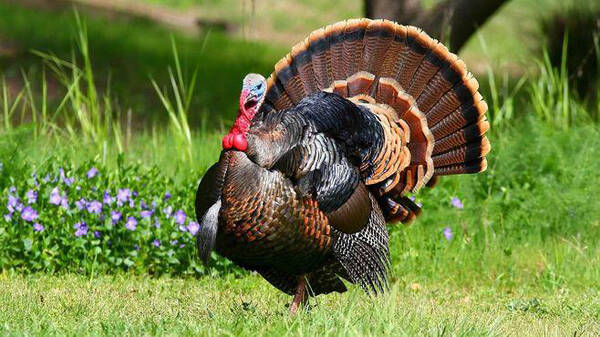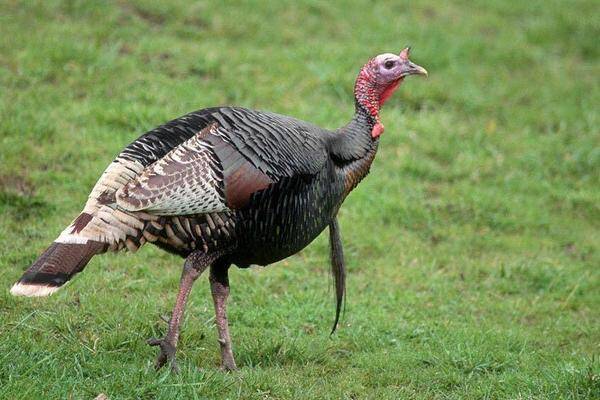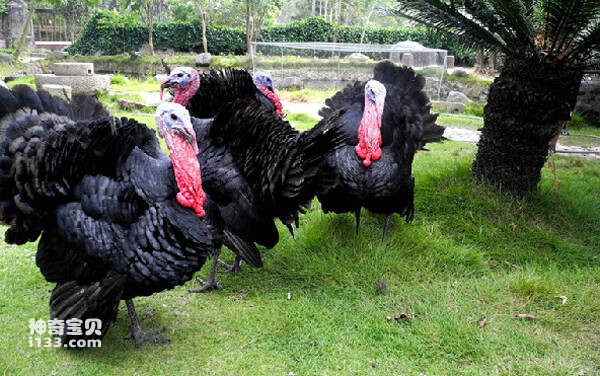Meleagris gallopavo
IUCN
LCBasic Information
Scientific classification
- name:Meleagris gallopavo
- Scientific Name:Meleagris gallopavo,Turkey,Wild Turkey
- Outline:Landfowl
- Family:Chickeniformes Pheasants Turkeys
Vital signs
- length:110-115cm
- Weight:2.5-10.8kg
- lifetime:3-10years
Feature
The head and neck are almost naked, only sparse feathers, and there is a red sarcoma down the throat
Distribution and Habitat
Country of origin: Canada, Mexico, USA.
Introduced to: Australia, New Zealand, Hawaii Islands.
Wild turkeys are found in large numbers in 21 states, from the East Coast of the United States to southern Mexico. In the West, it is found from Washington state to New Mexico and Texas.
Native to temperate and subtropical forests, wild turkeys prefer waterside woodlands and live in mountains, woods, and swamps in the United States. It lives between 300 and 2500 meters above sea level.
Appearance
Turkeys are 3-4 times larger than domestic chickens and 110 to 115 cm long. It has a wingspan of 125-144 cm and a weight of 2.5-10.8 kg. Mouth strong and slightly curved. The head and neck are almost naked, only sparse feathers, and there is a fleshy growth on the head, called sarcoma. Red lobes on the throat and neck. The back is slightly raised. The body feathers are metallic brown or green, scattered black stripes; Both wings have white spots; Tail feathers brown or gray, mottled, ends slightly rounded. Strong feet and toes. The body feathers range from milky white to brown gray to black brown black, shining metallic luster in many colors. The upper part of the head and neck are exposed, with a red coral-like dermatoma, and the lower throat has a fleshy lobe, which varies in color from red to purple. Turkeys exhibit strong sexual dimorphism. The male is much larger than the female, and his plumage comes in a rainbow of red, purple, green, copper, bronze, and gold. A male Turkey can
Details
The Turkey (Meleagris gallopavo) is known as Turkey, Wild Turkey, and has six subspecies.

Outside of the breeding season, males and females live separately, roosting in trees as high as possible. Meek and slow in action. When they are frightened, they quickly run to a hidden place, and they can fly 500-2000 meters. Usually lives on the ground, makes a gurgling sound. Wild turkeys must be very careful in the face of many predators. This is why many turkeys sleep on trees that grow in water, as they are not easily accessible from the ground. Turkeys are very heavy and difficult to fly, having to run a few meters to take off. Baby turkeys have a harder time, having to fly from branch to branch to sleep in the treetops.
Wild turkeys have many calls: swallowing, ordinary calls, purring, cackling, cutting, excited calls, etc. In early spring, males older than one year old (called gobblers or toms) and occasionally younger than one year old (called jakes) announce their presence to females and competing males by making big gulps. Wild turkeys can hear you a mile away. Male turkeys also make a low "drum sound," which is produced by the movement of air in the air sacs in the chest, similar to the roar of a prairie chicken. In addition, they produce a sound called "puking," which is the sound of a sharp expulsion of air from this sac.

Wild turkeys scratch the forest floor, turning leaves and pecking at plants. Young wild turkeys feed on berries, grass, buds, seeds, roots, and tubers. They change their vegetarian habits by eating insects (such as locusts) or some small crustaceans, mollusks and even amphibians. Wild turkeys swallow their food whole and grind it up with their powerful gizzards. Like many animals, it swallows small stones to facilitate this operation, but its digestive system is surprisingly efficient. The species has been seen swallowing small pieces of metal, and one Turkey was seen swallowing 24 whole nuts in four hours.
Wild turkeys have many enemies: coyotes, foxes, wolves, lynx, birds of prey, owls, raccoons, skunks, and minks. When approached by a potential predator, turkeys and their young often run away rather than fly away from the potential predator, and they may also fly short distances. Occasionally, if cornered, adult turkeys may try to fight off predators, while large male chickens can be particularly aggressive in self-defense. When fighting predators, turkeys may kick with their legs, use spines on the back of their legs as weapons, bite with their beaks, and strike with a relatively large body that may be able to deter medium-sized predators. Mother turkeys have been seen chasing away at least two kinds of eagles in flight when their chicks are threatened.

During mating season, turkeys parade around, cackling and proudly spreading their tail feathers. When an adult wild Turkey is in heat, its breast will bulge and pile up, forming an appendage called a "breast sponge." The species lives off this fat reserve and eats very little. When the Turkey seeks a mate, the male Turkey unfolds its tail feathers, droop its wings, shake its feathers, stutters its head, and makes a rapid "cackle" call. Their heads and necks are dyed bright colors of red, white, and blue. The color will change depending on the mood of the Turkey, with the pure white head and neck being the most excited. After the breeding season, the male turkeys are thin again. Each male tries to seduce as many females as possible and competes with other males for control of the harem.
Turkeys breed in early spring. Nesting on the ground. A male Turkey with a flock of females. Female turkeys build their nests by scraping slight depressions in the ground and filling them with dry leaves. Each clutch lays 8-15 pale brown spotted eggs, which hatch for 28 days. The baby Turkey is covered with gray speckled down. Feathers soon replace this down, but this feathering begins to change in August, and young turkeys get adult feathers at the end of the year. Under the watchful eye of the female, the chicks will move with her until they are three months old, at which point the larger males and smaller females will form separate groups.
Because the sex of birds, amphibians and fish is determined by the sex chromosomes carried by the eggs, parthenogenesis can be performed in certain circumstances, and turkeys are better at this. In the absence of male turkeys, unfertilized eggs produced by females can hatch, and the offspring they produce are usually weak and almost always male.
Listed on the IUCN Red List of Threatened Species (IUCN)2016 ver3.1 - Not Threatened (LC).
Protect wild animals and eliminate wild meat.
Maintaining ecological balance is everyone's responsibility!








